
The Celastraceae are a family of 98 genera and 1,350 species of herbs, vines, shrubs and small trees, belonging to the order Celastrales. The great majority of the genera are tropical, with only Celastrus, Euonymus and Maytenus widespread in temperate climates, and Parnassia (bog-stars) found in alpine and arctic climates.

Commiphora gileadensis, the Arabian balsam tree, is a shrub species in the genus Commiphora growing in Saudi Arabia, Yemen, southern Oman, Sudan and in southeast Egypt where it may have been introduced. Other common names for the plant include balm of Gilead and Mecca myrrh, but this is due to historical confusion between several plants and the historically important expensive perfumes and drugs obtained from them.
Blepharis dhofarensis is a species of plant in the family Acanthaceae. It is a shrub that grows to around 5m tall and is found in Oman and Yemen. Blepharis dhofarensis grows on wet escarpment woodlands and it prefers dense thickets on steep slopes. It is threatened by habitat loss. Recent molecular work has placed it in the genus Acanthus instead of Blepharis.

Gymnosporia is an Old World genus of plants, that comprise suffrutices, shrubs and trees. It was formerly considered congeneric with Maytenus, but more recent investigations separated it based on the presence of achyblasts and spines, alternate leaves or fascicles of leaves, an inflorescence that forms a dichasium, mostly unisexual flowers, and fruit forming a dehiscent capsule, with an aril on the seed. It is dioecious, with male and female flowers on separate plants.
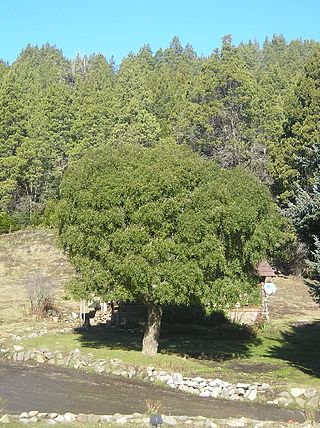
Maytenus is a genus of flowering plants in the family Celastraceae. Members of the genus are distributed throughout Central and South America, Southeast Asia, Micronesia, and Australasia, the Indian Ocean and Africa. They grow in a very wide variety of climates, from tropical to subpolar. The traditional circumscription of Maytenus was paraphyletic, so many species have been transferred to Denhamia and Gymnosporia.
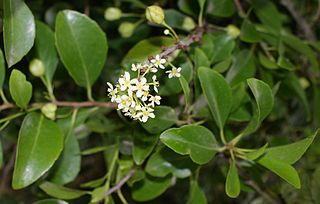
Gymnosporia cassinoides is a species of flowering plant in the family Celastraceae. It is a conservation-dependent shrub or tree endemic to the Canary Islands.
Gymnosporia stylosa is a species of flowering plant in the family Celastraceae. It is a scrambling shrub or tree native to Indo-China and Peninsular Malaysia. It is threatened by habitat loss.

Punica protopunica, commonly known as the pomegranate tree or Socotran pomegranate, is a species of flowering plant in the family Lythraceae. It is endemic to the island of Socotra (Yemen). Its natural habitat is subtropical or tropical dry forests.
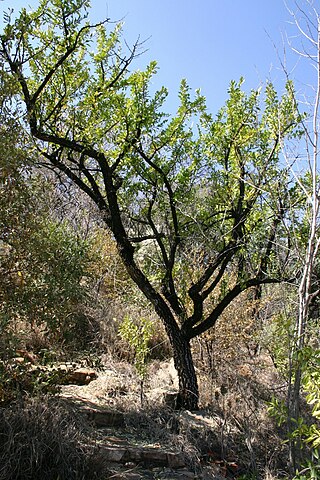
Gymnosporia heterophylla, the common spike-thorn, is a small, hardy, deciduous African tree up to 5m tall, occurring in rocky places with a wide distribution from Ethiopia, the Sudan and the Congo, south to the Cape Province and west to Angola and Namibia, as well as the neighbouring islands of Madagascar and Saint Helena, with a closely related species from Mauritius.
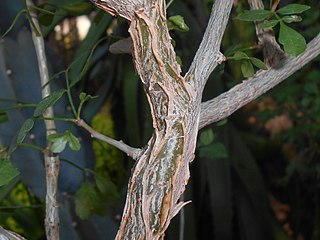
Commiphora kua, sometimes known as Abyssinian myrrh or the Yemen myrrh, is a plant native to northeast Africa and the Arabian Peninsula, including Djibouti, Eritrea, Ethiopia, Zambia, Malawi, Oman and Yemen. It was first described as Balsamodendrum kua in 1847, and has many botanical synonyms. It can be recognised by its simple, serrate leaves and by the pseudo aril, covering the seed, which has four almost linear arm-like lobes.
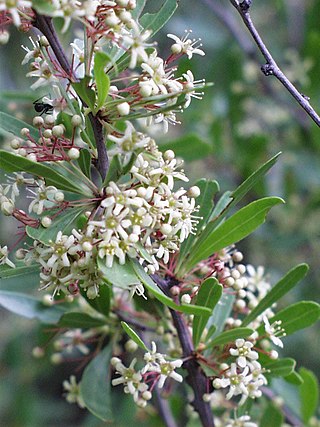
Gymnosporia tenuispina is a Southern African shrub or small tree of about 2 metres in height belonging to the family Celastraceae.

Gymnosporia nemorosa is a spiny, somewhat sprawling evergreen shrub or small tree with drooping branches growing to some 5 m tall and found along forest edges in Mpumalanga, Eswatini, KwaZulu-Natal south to the Garden Route in the Southern Cape. In Maputaland the species adopts the form of a geoxylic suffrutex or ‘underground’ tree, with shoots sprouting from its woody, underground axis.

Lycium shawii, desert thorn or Arabian boxthorn is a species of thorny shrub adapted to desert environments, and can be found throughout the Arabian Peninsula, and some places in Africa. The thin leaved, rigid bush grows up to 3 metres high, with a lot of branches and alternating spines that vary in size, and grow along the branches and on their tips. The leaves narrow towards their base. It produces small whitish-pink or purple flowers from September until April, and red pea-sized seedy berries that are edible. Habitats include gravel plains and foothills up to 4,000 ft (1,200 m), as well as wadis. Plants often growing nearby include Acacia tortilis and Prosopis cineraria.

Gymnosporia thompsonii is a species of plant in the bittersweet family Celastraceae. It is endemic to the Mariana and Caroline Islands, where it grows as a many-stemmed understory shrub or small tree in karst forests. Its wood is used for fuel and its leaves are used medicinally.

The Southwestern Arabian foothills savanna, also known as the Southwestern Arabian Escarpment shrublands and woodlands, is a desert and xeric shrubland ecoregion of the southern Arabian Peninsula, covering portions of Saudi Arabia, Yemen, and Oman.

The South Arabian fog woodlands, shrublands, and dune is an ecoregion in Oman and Yemen. The fog woodlands lie on mountainsides which slope southeastwards towards the Arabian Sea. The mountains intercept moisture-bearing winds from the Arabian Sea, creating orographic precipitation and frequent fogs that sustain unique woodlands and shrublands in a desert region.
Gymnosporia arbutifolia is a species of flowering plant in the family Celastraceae. It is a thorny shrub or tree native to eastern Africa and the Arabian Peninsula. It grows in the mountains of eastern Africa, from the Ethiopian Highlands to the Albertine Rift, and to the southeastern Arabian Peninsula, from 1350 to 2080 meters elevation.
Maytenus umbellata is a species of plant in the family Celastraceae. Common names include Buxo-da-rocha and Madeira shrubby bittersweet. It is endemic to Madeira.

Maytenus senegalensis, also known as arto, arto negro or espino cambrón in Spanish is a thorny shrub of the Celastraceae family. Endemic to Ibero-Africa, it is an endangered species and listed as vulnerable. It contains cathinone and cathine.
















